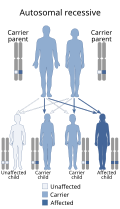Lan blood group system
| ABCB6 (Lan blood group antigen; LAN1) | |||||||
|---|---|---|---|---|---|---|---|
| Identifiers | |||||||
| Symbol | ABCB6 | ||||||
Chr. 2 q36 | |||||||
| |||||||
The Lan blood group system (short for Langereis) is a human
Molecular biology

The Lan antigen is carried on the protein
ABCB6 is involved in
Epidemiology
The prevalence of the Lan antigen exceeds 99.9% in most populations. The frequency of the Lan-negative blood type is estimated at 1 in 50,000 in Japanese populations, 1 in 20,000 in Caucasians, and 1 in 1,500 in black people from South Africa.[2]
Clinical significance
When Lan-negative individuals are exposed to Lan-positive blood through
Laboratory testing
Serologic reagents and molecular assays for Lan
Anti-Lan antibodies are typically composed of
: 220History
The Lan antigen was first described in 1961 by Van der Hart et al.,[8] when a Dutch patient suffered a severe hemolytic transfusion reaction.[4]: 220 [5]: 489 The patient was found to produce an antibody that reacted with all but 1 out of 4,000 blood donors tested. The causative antigen was identified and designated "Langereis" after the patient's last name.[2] Lan was officially designated a blood group by the International Society of Blood Transfusion in 2012, following the discovery of the molecular basis of the Lan-negative phenotype.[4]: 220 [9][10]
References
- ^ a b c Bocchini CA (2015). "#111600 - BLOOD GROUP, LANGEREIS SYSTEM; LAN". Online Mendelian Inheritance in Man. Retrieved 16 May 2020.
- ^ S2CID 38708222.
- S2CID 52933848. Archived from the original(PDF) on 2021-07-13. Retrieved 2020-05-16.
- ^ ISBN 978-0-8036-9462-0.
- ^ ISBN 978-1-118-49354-0.
- S2CID 84328440.
- PMID 30271928.
- ^ van der Hart M, Moes M, van der Veer M, van Loghem JJ (1961). "Ho and Lan—two new blood group antigens". Proceedings of the 8th Congress of the European Society of Haematology, Vienna (Austria): 493–505.
- PMID 22246506.
- S2CID 83580827.
